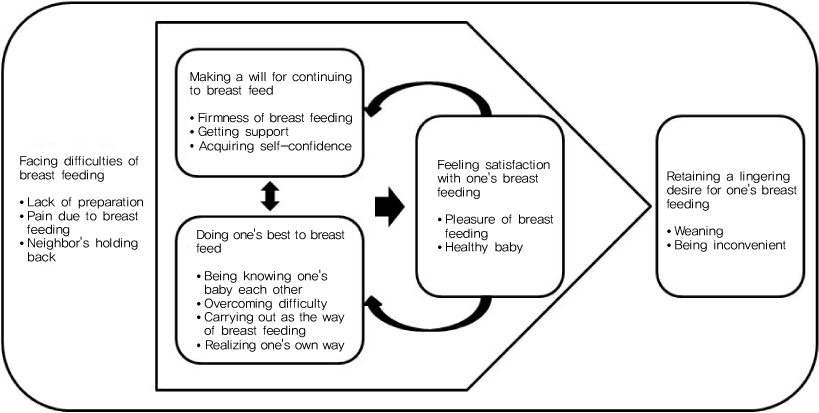Korean J Women Health Nurs.
2009 Sep;15(3):186-195. 10.4069/kjwhn.2009.15.3.186.
Process of Breast Feeding Mother's Adaptation
- Affiliations
-
- 1Department of Nursing Science, Ewha Womans University, Seoul, Korea. carpesun@hanmail.net
- KMID: 2308406
- DOI: http://doi.org/10.4069/kjwhn.2009.15.3.186
Abstract
- PURPOSE
This study aimed to explore the breast feeding processof mothersand to develop agroundedtheory about experiences of breast feeding women. METHODS: Data was collected by means of an in-depth interview from 8 participants who were breast feeding their baby. The data was analyzed using the grounded theory methodology proposed by Strauss and Corbin. RESULTS: The core category was discovered to be 'becoming a mother'. This process was categorized into 5 stages; 'facing difficulties of breast feeding', 'having the will to continue to breast feed', 'doing one's best to breast feed', 'feeling satisfactionwithone'sbreast feeding', and'retainingalingering desire for one's breast feeding'. Mothers began breast feeding without preparation. They faced difficult problems during breast feeding such as getting a lay-person's or professional person's support. They made various efforts for continuing to breast feed and solve the problems. They got pleasure from breast feeding, their baby is fine, and they have a bond with their baby. Finally, when they finished breast feeding, they still felt attached to it and had regrets. CONCLUSION: This study provided the information about mothers' experiences in the breast feedingprocess. Therefore, nurses will be ableto utilize successful adaptationskills forhelpingbreast feedingmothers.
Keyword
Figure
Reference
-
1. American Academy of Pediatrics. Breastfeeding and the use of human milk. Pediatrics. 2005. 115(2):496–506.2. Dennis C.L. Breastfeeding initiation and duration: A 1990-2000 literature review. J Obstet Gynecol Neonatal Nurs. 2002. 31(1):12–32.
Article3. Fraser D.M., Cullen L.C. Postnatal management and breastfeeding. Curr Obstet Gynaecol. 2006. 16(2):65–71.
Article4. Huggins K., Ziedrich L. The nursing mother's guide to weaning. 2007. Boston: The Harvard Common Press.5. Kim H.S. The guideline book for breastfeeding. 2001. Seoul: Hyunmoonsa.6. Kim H.S., Nam E.S. Prediction of breastfeeding intentions and behaviors: An application of the theory of planned behavior. J Korean Acad Nurs. 1997. 27(4):796–806.7. Kim S.J., Yang S.J. A study of primiparous women's breastfeeding experience. J Korean Acad Nurs. 1997. 27(3):477–488.
Article8. Kim Y.H. The psychological process of 'becoming a mother' focused on breastfeeding: The grounded theory approach. 2006. Seoul: Seoul Women's University;Unpublished doctoral dissertation.9. Kong S.K.F., Lee D.T.F. Factors influencing decision to breastfeed. J Adv Nurs. 2004. 46(4):369–379.
Article10. Kronborg H., Vaeth M. The influence of psychosocial factors on the duration of breastfeeding. Scand J Public Health. 2004. 32(3):210–216.
Article11. Lawrence R.A., Lawrence R.M. Breastfeeding: A guide for the medical profession. 2005. 6th ed. Philadelphia: Elsevier Mosby.12. Lewallen L.P., Dick M.J., Flowers J., Powell W., Zickefoose K.T., Wall Y.G., et al. Breastfeeding support andearly cessation. J Obstet Gynecol Neonatal Nurs. 2006. 35(2):166–172.13. 2005 Korean national health and nutrition survey: Nutrition survey. Ministry of Health, Welfare and Family Affairs. 2006. 07. 05. Retrieved October 12, 2007. from http://www.w3.org/1999/xlink" xlink:href="http://www.mw.go.kr/front/al/sal0301vw.jsp?PAR_MENU_ID=04&MENU_ID=0403&page=1&BOARD_ID=140&BOARD_FLAG=&CONT_SEQ=38330&SEARCHKEY=TITLE&SEARCHVALUE=&CREATE_DATE1=&CREATE_DATE2=.14. Mitra A.K., Khoury A.J., Hinton A.W., Carothers C. Predictors of breastfeeding intention among low-income women. Matern Child Health J. 2004. 8(2):65–70.
Article15. Moore E.R., Coty M. Prenatal and postpartum focus groups with primiparas: Breastfeeding attitudes, support, barriers, self-efficacy, and intention. J Pediatr Health Care. 2006. 20(1):35–46.
Article16. Moran V.H., Dinwoodie K., Bramwell R., Dykes F. A critical analysis of the content of the tools that measure breastfeeding interaction. Midwifery. 2000. 16(4):260–268.
Article17. Nelson A., Sethi S. The breastfeeding experiences of Canadian teenage mothers. J Obstet Gynecol Neonatal Nurs. 2005. 34(5):615–624.
Article18. Rempel L.A., Fong G.T. Why breastfeed? A longitudinal test of the reasons model among first-time mothers. Psychol Health. 2005. 20(4):443–466.
Article19. Strauss A., Corbin J. Basics of qualitative research: Techniques and procedures for developing grounded theory. 1998. 2nd ed. Thousand Oaks: Sage Publications.20. Tomas J.R., Shaikh U. Electronic communication with patients for breastfeeding support. J Hum Lact. 2007. 23(3):275–279.
Article21. Yeo J.H. Influencing factors in breast feeding duration. Korean J Women Health Nurs. 2005. 11(2):142–147.
Article
- Full Text Links
- Actions
-
Cited
- CITED
-
- Close
- Share
- Similar articles
-
- Effects of Breast-feeding Adaptation, Attitude and Practice of Primipara Depending on Method of Postpartum Breast-feeding Education
- Study on Mother's knowledge level of Breast feeding and Nursing Activities related to Breast feeding perceived by Mother
- Effects of a Breast Feeding Promotion Program for Working Women
- A Study On Performance of Breast-feeding by Employed mother
- Concept Analysis of Effective Breastfeeding


